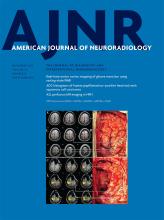Index by author
November 01, 2017; Volume 38,Issue 11
Hoffman, D.
- Pediatric NeuroimagingYou have accessVolume of Structures in the Fetal Brain Measured with a New Semiautomated MethodR. Ber, D. Hoffman, C. Hoffman, A. Polat, E. Derazne, A. Mayer and E. KatorzaAmerican Journal of Neuroradiology November 2017, 38 (11) 2193-2198; DOI: https://doi.org/10.3174/ajnr.A5349
Hojjat, S.-P.
- Adult BrainYou have accessDetection of Volume-Changing Metastatic Brain Tumors on Longitudinal MRI Using a Semiautomated Algorithm Based on the Jacobian Operator FieldO. Shearkhani, A. Khademi, A. Eilaghi, S.-P. Hojjat, S.P. Symons, C. Heyn, M. Machnowska, A. Chan, A. Sahgal and P.J. MaralaniAmerican Journal of Neuroradiology November 2017, 38 (11) 2059-2066; DOI: https://doi.org/10.3174/ajnr.A5352
Holodny, A.I.
- Spine Imaging and Spine Image-Guided InterventionsOpen AccessT1-Weighted Dynamic Contrast-Enhanced MR Perfusion Imaging Characterizes Tumor Response to Radiation Therapy in ChordomaP. Santos, K.K. Peck, J. Arevalo-Perez, S. Karimi, E. Lis, Y. Yamada, A.I. Holodny and J. LyoAmerican Journal of Neuroradiology November 2017, 38 (11) 2210-2216; DOI: https://doi.org/10.3174/ajnr.A5383
Honig, S.
- LetterYou have accessEmergency Department MR Imaging Scanner: Supportive DataD.M. Yousem, J. Pakpoor, L. Babiarz and S. HonigAmerican Journal of Neuroradiology November 2017, 38 (11) E88; DOI: https://doi.org/10.3174/ajnr.A5315
Hou, Q.
- Pediatric NeuroimagingOpen AccessClinical and Imaging Characteristics of Arteriopathy Subtypes in Children with Arterial Ischemic Stroke: Results of the VIPS StudyM. Wintermark, N.K. Hills, G.A. DeVeber, A.J. Barkovich, T.J. Bernard, N.R. Friedman, M.T. Mackay, A. Kirton, G. Zhu, C. Leiva-Salinas, Q. Hou, H.J. Fullerton and the VIPS InvestigatorsAmerican Journal of Neuroradiology November 2017, 38 (11) 2172-2179; DOI: https://doi.org/10.3174/ajnr.A5376
Hsiung, G.-Y.R.
- LetterYou have accessCerebral Microbleeds: A Call for Standardized Advanced NeuroimagingA. Rauscher, G.-Y.R. Hsiung and A.A. SepehryAmerican Journal of Neuroradiology November 2017, 38 (11) E90-E91; DOI: https://doi.org/10.3174/ajnr.A5323
Huisman, T.A.G.M.
- Pediatric NeuroimagingYou have accessDoes the Addition of a “Black Bone” Sequence to a Fast Multisequence Trauma MR Protocol Allow MRI to Replace CT after Traumatic Brain Injury in Children?M.H.G. Dremmen, M.W. Wagner, T. Bosemani, A. Tekes, D. Agostino, E. Day, B.P. Soares and T.A.G.M. HuismanAmerican Journal of Neuroradiology November 2017, 38 (11) 2187-2192; DOI: https://doi.org/10.3174/ajnr.A5405
Hwang, L.
- Peripheral Nervous SystemYou have accessMR Neurography of Greater Occipital Nerve Neuropathy: Initial Experience in Patients with MigraineL. Hwang, R. Dessouky, Y. Xi, B. Amirlak and A. ChhabraAmerican Journal of Neuroradiology November 2017, 38 (11) 2203-2209; DOI: https://doi.org/10.3174/ajnr.A5354
Jabouley, A.
- Adult BrainOpen AccessReaction Time Is Negatively Associated with Corpus Callosum Area in the Early Stages of CADASILS. Delorme, F. De Guio, S. Reyes, A. Jabouley, H. Chabriat and E. JouventAmerican Journal of Neuroradiology November 2017, 38 (11) 2094-2099; DOI: https://doi.org/10.3174/ajnr.A5378
Jimenez, C.M.
- EDITOR'S CHOICENeurointerventionOpen AccessAngioarchitectures and Hemodynamic Characteristics of Posterior Communicating Artery Aneurysms and Their Association with Rupture StatusB.J. Chung, R. Doddasomayajula, F. Mut, F. Detmer, M.B. Pritz, F. Hamzei-Sichani, W. Brinjikji, D.F. Kallmes, C.M. Jimenez, C.M. Putman and J.R. CebralAmerican Journal of Neuroradiology November 2017, 38 (11) 2111-2118; DOI: https://doi.org/10.3174/ajnr.A5358
The authors studied 313 posterior communicating artery aneurysms (145 ruptured, 168 unruptured) with image-based computational fluid dynamics. Aneurysms were classified into different angioarchitecture types depending on the location of the aneurysm with respect to parent artery bifurcation. Ruptured aneurysms had higher, more concentrated, and more oscillatory wall shear stress distributions; stronger and more concentrated inflow jets; and more complex and unstable flow patterns compared with unruptured aneurysms. They conclude that high-flow intrasaccular hemodynamic characteristics, commonly found in bifurcation-type angioarchitectures, are associated with the posterior communicating artery aneurysm rupture status.
In this issue
American Journal of Neuroradiology
Vol. 38, Issue 11
1 Nov 2017
Advertisement
Advertisement








